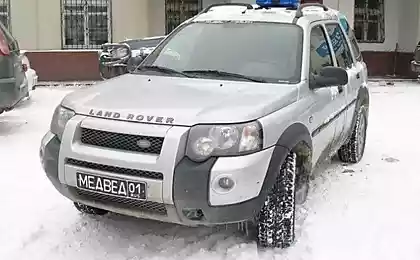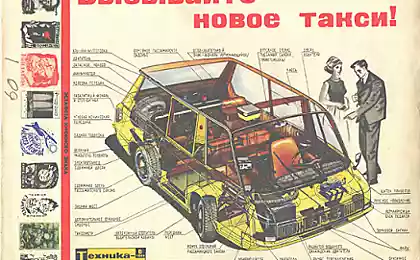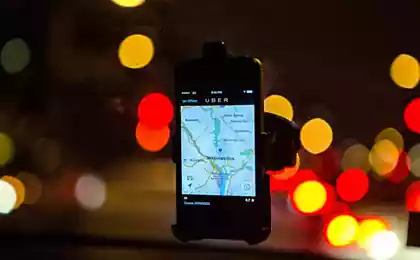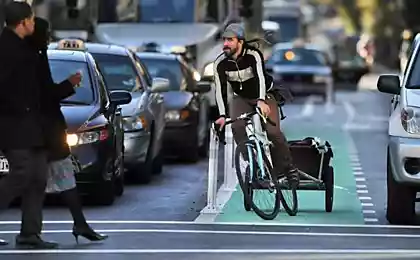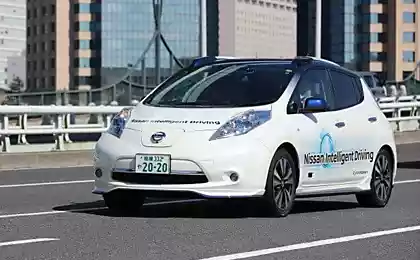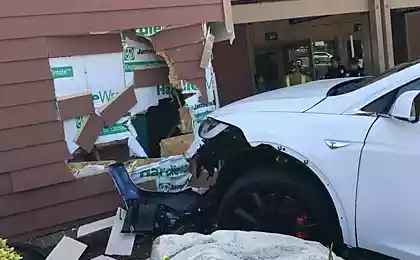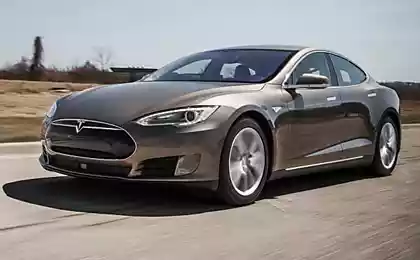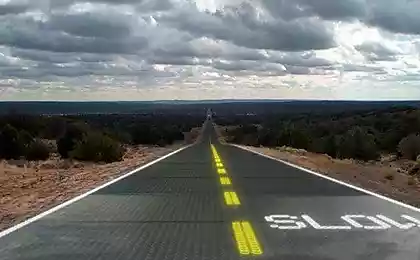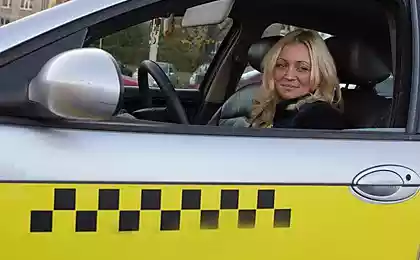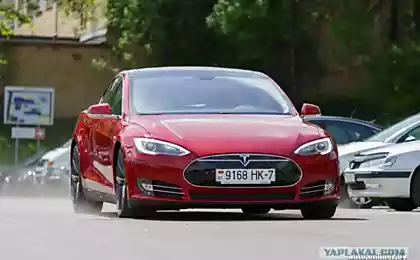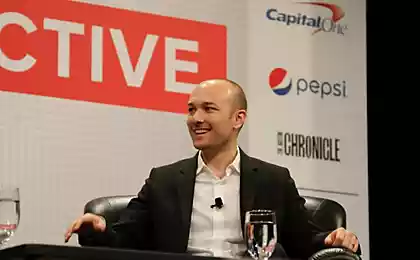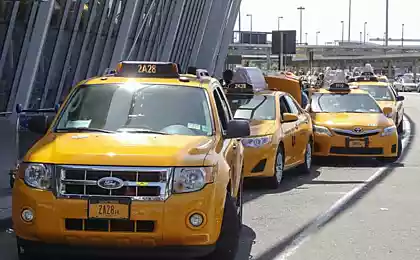517
As I traveled by car Uber without a driver
Recently Uber, who broke the bridges between tech startups and taxi service, with pomp came to our country. And today journalist Alex Davies rode the first self-driving car, Uber, and told about their experiences. And let now this story seems fiction (especially in our region all comes late), remember that 2 years ago, Uber was just starting his crusade in the fight against ordinary taxi drivers, but about self-driving cars, we learned only thanks to leaks from Google offices.
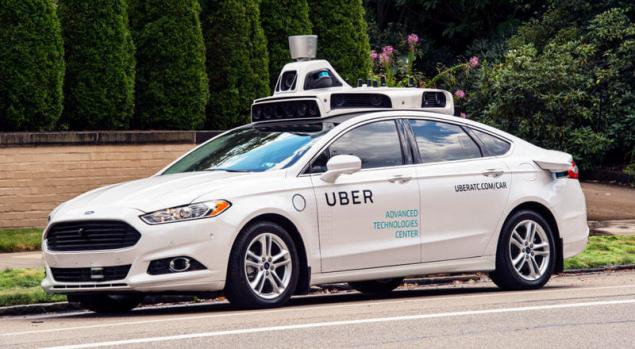
My taxi looks as usual — I pull out his smartphone and open the app Uber. Using geo-location choose a place of delivery of the car, to drive where I need to be and order a taxi. Then on the horizon appears a robot.
This white Ford Fusion, the roof of which "wearing" big hat from the guide cameras and lasers, which certainly would be enough to highlight the latest super bowl American football. This is the latest Uber weapon in the war with the usual system of road transport. As of this morning, some Uber users living in the heart of Pittsburgh, had the opportunity to order a taxi with the robot driver.

The purpose of Uber straight, as the angle of the house — make your business more efficient and profitable, throwing out a working chain of taxi drivers who take home the majority of the abandoned client money. Or, the engineer says that Uber, which controlled the operation of the autopilot during the trip (just in case), "to get rid of the overhead." Well, a little bit to reduce the frightening statistics of deaths on the roads. And that 1.2 million people annually.
"Robelot really throws the ball far into the opponents' half," says Raffi Krikorian who manages the centre of excellence for Uber in Pittsburgh.
Finding himself in the backseat and slipping a little on the reddish-brown leather seats, I notice that this machine is not much different from any other. In the first place catches the eye is a big red button instead of coasters for mugs of coffee. In which case, it switches off the autopilot. On a nearby front seat collapsed the electrical engineer with a laptop, which delves into the to me incomprehensible data streams that are transmitted by the autopilot. The only thing that distinguishes this machine from any other taxi is mounted between the front seats touch screen looking right at me.
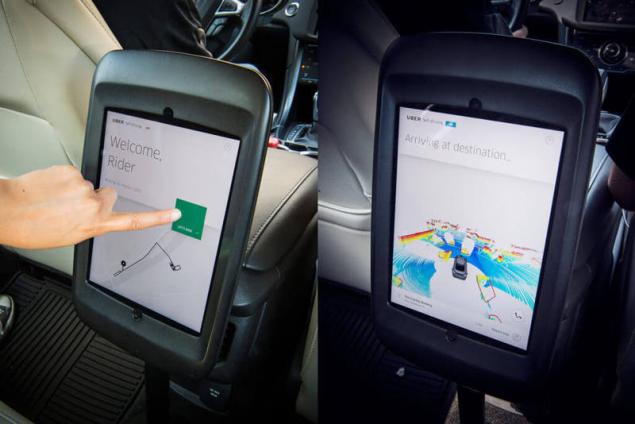
"Welcome, Alex, — he writes. Let's take a ride".
Unlike most companies, which coin is fully Autonomous cars, Uber want you to enjoy a new experience. The guy from the front seat tells me that the launch of the taxi with the autopilot is half the battle. The second half is an attempt to understand what about this does not think an engineer or a geek, but an ordinary person like you or me.
And the need for this display. In it you will find answers to the most frequently asked questions such as maximum speed of a taxi (25-30 miles per hour, she drives too fast), or why the roof needs all the antennas and cameras. "We want to provide our clients with all their interesting information, so they feel safe," explains Emily Bartel, Manager of product development Uber.
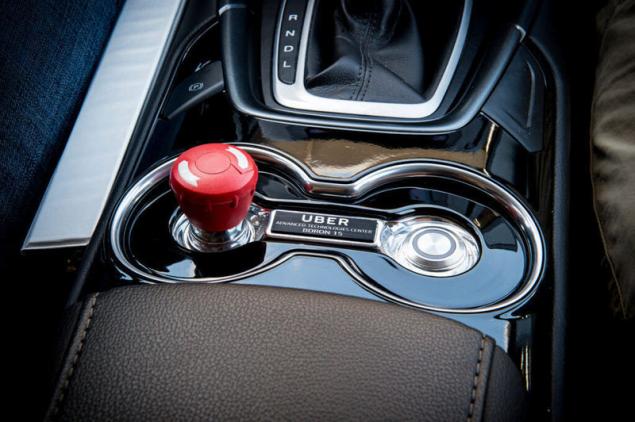
The screen tells you exactly when the autopilot works, how fast it goes and where it is in the moment you are. The remaining two-thirds of the screen show the machine itself and how it sees the road with his lidar (Prim: active range finder optical range, the most expensive and complex part of the pilot). The main idea of this screen is the ability to show the way the eyes of the robot, making it easier for the passenger.
My trip starts from warehouses around the Polish mountains on the outskirts of Pittsburgh and extends to the center of the city on one of the bridges over the Allegheny river. If the car does not need to perform complex maneuvers, the trip runs smoothly with occasional bouts of sudden braking or acceleration. However, the engineer Uber intercepts the machine every 2 minutes. Now he is unhappy with the way the car was in no hurry to slow down to let a pedestrian. The last time he didn't like how we stopped in front of a parked truck, waiting for when he will finally go.
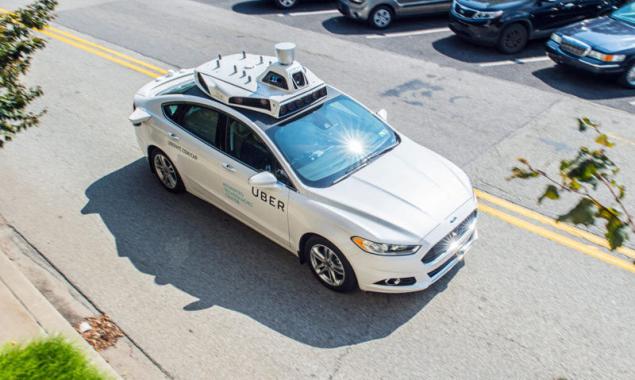
All the time while we're gone, people on the street constantly turn around and take pictures of our car, and I feel like the Queen of England. Although Uber operates in Pittsburgh for the past 18 months, this is the first self-driving car on the local roads. The other has not yet traveled outside of silicon valley. For the test chose Pittsburgh for several reasons.
First, here is the University Carnegie Mellon, which develop the system of Autonomous driving. Second, there are very difficult conditions for testing: the city is a grid of bridges, the streets here are narrow and convoluted, and the weather regularly pleases with snow and rain. And, maybe the company just liked the enthusiasm that the city authorities are to advanced technologies.

"First, there are innovations and then the laws which regulate it. And never Vice versa. So technology startups are constantly looking for places where their innovation will be happy, — says the mayor of Pittsburgh bill Peduto. — If you stop the clock and turn off the phone, you will see that soon all of these technologies and the jobs will be in another city."
And if States like Michigan, California or Nevada technological innovations are strictly regulated by the law, PA in this regard looks as a children's party, where there are no educators. In this state there are no clear rules that, to me, very cool — in fact within 30 minutes of the trip the engineer Uber asked me if I wanted to take the wheel. Or rather, sit in the driver's seat, because there is no conventional rudder.

But even in the pilot I can't click on the silver button and go back to San Francisco. Like any stand-alone mechanism, the machine requires Uber incredibly detailed road map, which instead of processing the roadway will allow her to focus on other cars, pedestrians and traffic lights.
The creation of such maps as follows: you send the loaded sensors the car in a certain urban area. Then the driver goes 7-8 times back and forth on the same road while sensors collect information about traffic lights, road crossings, speed limits, etc. Then the software processes this information and draws clear for a robot map. In fact, it is automation in the creation of such detailed maps is the key to the taxi without the meat bag behind the wheel.
When it happens in Uber did not say. According to their competitors, they draw a period of 3-5 years. But they say that Uber is ready to share its experience and best practices. And no more talk about anything with the driver. published
SUBSCRIBE to OUR youtube channel that allows you to watch online, download from YouTube for free videos.
Put LIKES and share with your FRIENDS!
www.youtube.com/channel/UCXd71u0w04qcwk32c8kY2BA/videos
Source: gagadget.com/business/23747-kak-ya-ezdil-na-avtomobile-uber-bez-voditelya/

My taxi looks as usual — I pull out his smartphone and open the app Uber. Using geo-location choose a place of delivery of the car, to drive where I need to be and order a taxi. Then on the horizon appears a robot.
This white Ford Fusion, the roof of which "wearing" big hat from the guide cameras and lasers, which certainly would be enough to highlight the latest super bowl American football. This is the latest Uber weapon in the war with the usual system of road transport. As of this morning, some Uber users living in the heart of Pittsburgh, had the opportunity to order a taxi with the robot driver.

The purpose of Uber straight, as the angle of the house — make your business more efficient and profitable, throwing out a working chain of taxi drivers who take home the majority of the abandoned client money. Or, the engineer says that Uber, which controlled the operation of the autopilot during the trip (just in case), "to get rid of the overhead." Well, a little bit to reduce the frightening statistics of deaths on the roads. And that 1.2 million people annually.
"Robelot really throws the ball far into the opponents' half," says Raffi Krikorian who manages the centre of excellence for Uber in Pittsburgh.
Finding himself in the backseat and slipping a little on the reddish-brown leather seats, I notice that this machine is not much different from any other. In the first place catches the eye is a big red button instead of coasters for mugs of coffee. In which case, it switches off the autopilot. On a nearby front seat collapsed the electrical engineer with a laptop, which delves into the to me incomprehensible data streams that are transmitted by the autopilot. The only thing that distinguishes this machine from any other taxi is mounted between the front seats touch screen looking right at me.

"Welcome, Alex, — he writes. Let's take a ride".
Unlike most companies, which coin is fully Autonomous cars, Uber want you to enjoy a new experience. The guy from the front seat tells me that the launch of the taxi with the autopilot is half the battle. The second half is an attempt to understand what about this does not think an engineer or a geek, but an ordinary person like you or me.
And the need for this display. In it you will find answers to the most frequently asked questions such as maximum speed of a taxi (25-30 miles per hour, she drives too fast), or why the roof needs all the antennas and cameras. "We want to provide our clients with all their interesting information, so they feel safe," explains Emily Bartel, Manager of product development Uber.

The screen tells you exactly when the autopilot works, how fast it goes and where it is in the moment you are. The remaining two-thirds of the screen show the machine itself and how it sees the road with his lidar (Prim: active range finder optical range, the most expensive and complex part of the pilot). The main idea of this screen is the ability to show the way the eyes of the robot, making it easier for the passenger.
My trip starts from warehouses around the Polish mountains on the outskirts of Pittsburgh and extends to the center of the city on one of the bridges over the Allegheny river. If the car does not need to perform complex maneuvers, the trip runs smoothly with occasional bouts of sudden braking or acceleration. However, the engineer Uber intercepts the machine every 2 minutes. Now he is unhappy with the way the car was in no hurry to slow down to let a pedestrian. The last time he didn't like how we stopped in front of a parked truck, waiting for when he will finally go.

All the time while we're gone, people on the street constantly turn around and take pictures of our car, and I feel like the Queen of England. Although Uber operates in Pittsburgh for the past 18 months, this is the first self-driving car on the local roads. The other has not yet traveled outside of silicon valley. For the test chose Pittsburgh for several reasons.
First, here is the University Carnegie Mellon, which develop the system of Autonomous driving. Second, there are very difficult conditions for testing: the city is a grid of bridges, the streets here are narrow and convoluted, and the weather regularly pleases with snow and rain. And, maybe the company just liked the enthusiasm that the city authorities are to advanced technologies.

"First, there are innovations and then the laws which regulate it. And never Vice versa. So technology startups are constantly looking for places where their innovation will be happy, — says the mayor of Pittsburgh bill Peduto. — If you stop the clock and turn off the phone, you will see that soon all of these technologies and the jobs will be in another city."
And if States like Michigan, California or Nevada technological innovations are strictly regulated by the law, PA in this regard looks as a children's party, where there are no educators. In this state there are no clear rules that, to me, very cool — in fact within 30 minutes of the trip the engineer Uber asked me if I wanted to take the wheel. Or rather, sit in the driver's seat, because there is no conventional rudder.

But even in the pilot I can't click on the silver button and go back to San Francisco. Like any stand-alone mechanism, the machine requires Uber incredibly detailed road map, which instead of processing the roadway will allow her to focus on other cars, pedestrians and traffic lights.
The creation of such maps as follows: you send the loaded sensors the car in a certain urban area. Then the driver goes 7-8 times back and forth on the same road while sensors collect information about traffic lights, road crossings, speed limits, etc. Then the software processes this information and draws clear for a robot map. In fact, it is automation in the creation of such detailed maps is the key to the taxi without the meat bag behind the wheel.
When it happens in Uber did not say. According to their competitors, they draw a period of 3-5 years. But they say that Uber is ready to share its experience and best practices. And no more talk about anything with the driver. published
SUBSCRIBE to OUR youtube channel that allows you to watch online, download from YouTube for free videos.
Put LIKES and share with your FRIENDS!
www.youtube.com/channel/UCXd71u0w04qcwk32c8kY2BA/videos
Source: gagadget.com/business/23747-kak-ya-ezdil-na-avtomobile-uber-bez-voditelya/
In Samara create a battery with a lifespan of 100 years
The first plate solar sidewalk installed in Idaho





